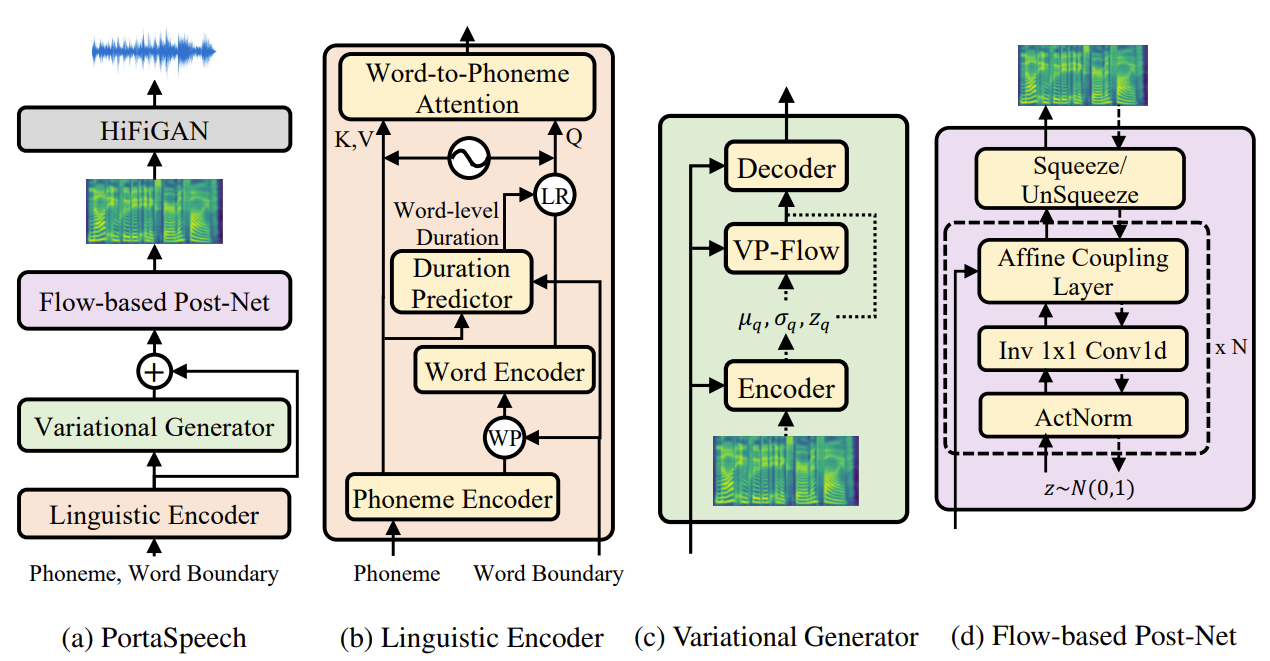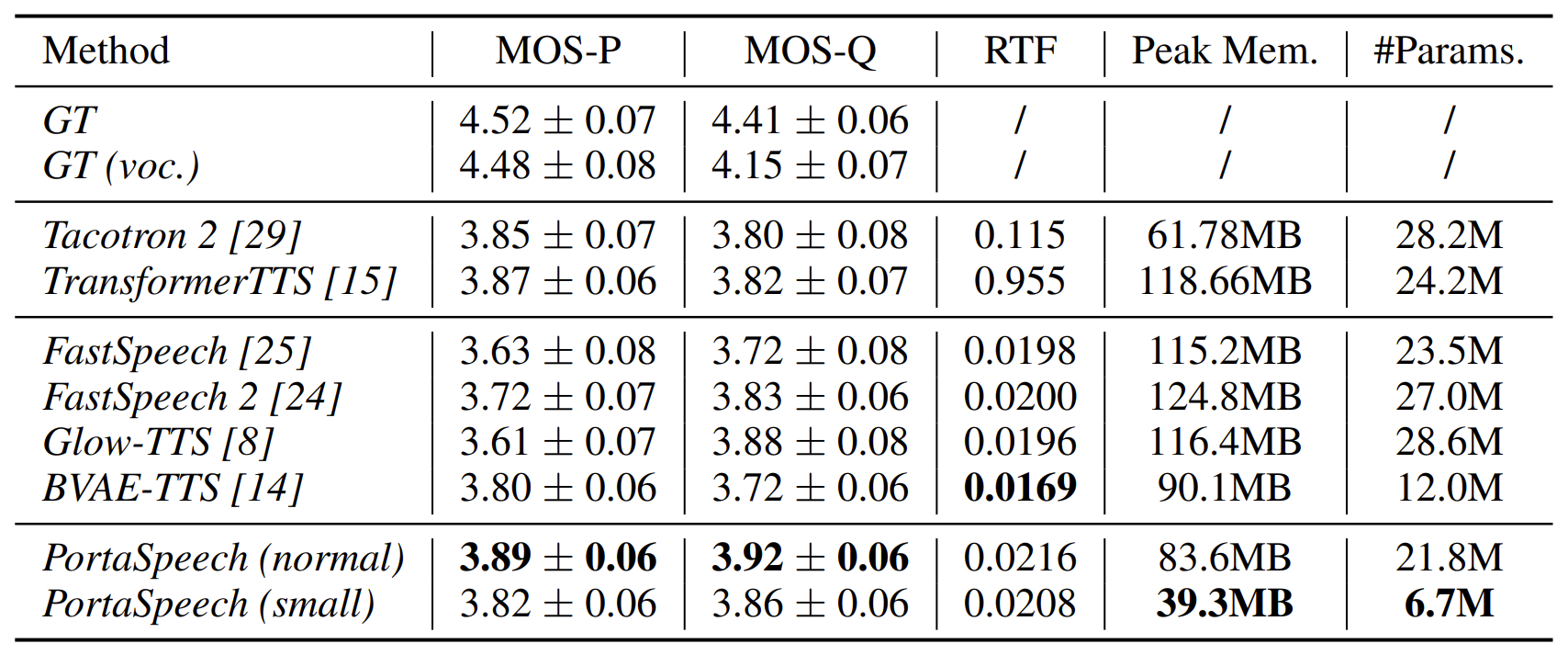티스토리 뷰
Paper/TTS
[Paper 리뷰] PortaSpeech: Portable and High-Quality Generative Text-to-Speech
feVeRin 2024. 3. 2. 12:13반응형
PortaSpeech: Portable and High-Quality Generative Text-to-Speech
- Non-autoregressive Text-to-Speech 모델은 고품질의 음성 합성이 가능하지만 몇 가지 한계가 있음
- VAE는 작은 모델 size로도 long-range semantic feature를 capture 할 수 있지만, 종종 부자연스러운 결과를 생성함
- Normalizing Flow는 frequency bin-wise detail을 reconstruct 하는데 좋지만, 많은 parameter 수를 필요로 함 - PortaSpeech
- Lightweight architecture를 사용하여 고품질의 음성 합성을 지원하는 TTS 모델
- Enhanced prior를 포함한 lightweight VAE와 strong conditional input을 가진 flow-based post-net을 활용
- 모델 size를 줄이기 위해 post-net의 affine coupling layer에 grouped parameter sharing을 도입
- Hard word-level alignment와 soft phoneme-level alignment를 결합한 mixture alignment를 채택
- 논문 (NeurIPS 2021) : Paper Link
1. Introduction
- Text-to-Speech (TTS)에서 non-autoregressive architecture를 활용하면 우수한 품질과 빠른 추론 속도를 달성할 수 있음
- 특히 최신 TTS 모델은 아래와 같은 요구사항의 만족을 목표로 하고 있음
- Fast : 계산 resource 비용을 줄이고 real-time application으로 확장하기 위해서는 모델의 추론 속도가 빨라야 함
- Lightweight : 모델을 mobile/edge device에 배포하기 위해서는 모델 size와 runtime memory가 작아야 함
- High-Quality : 합성 품질의 향상을 위해 모델은 adjacent harmonics, unvoiced frame, high-frequency 등의 natural detail을 capture 할 수 있어야 함
- Expressive : Expressive한 음성을 생성하기 위해, 적절한 prosody 모델링을 통해 fundamental frequency와 duration을 정확하게 예측할 수 있어야 함
- Diverse : 하나의 text input sequence가 주어지면 모델은 다양한 intonation을 가진 sample을 합성할 수 있어야 함
- 위의 목표를 달성할 수 있는 lightweight TTS 모델이 필요
- 특히 최신 TTS 모델은 아래와 같은 요구사항의 만족을 목표로 하고 있음
-> 그래서 lightweight architecture를 사용하여 고품질의 음성 합성을 수행하는 PortaSpeech를 제안
- PortaSpeech
- VAE가 long-range semantic feature를 capture 하는데 유리하고 Normalizing flow는 frequency bin-wise detail을 reconstruct 하는데 유리하다는 점을 활용
- Enhanced prior를 갖춘 VAE와 flow-based post-net을 결합하여 고품질의 음성을 생성 - VAE는 작은 모델 size로도 prosody를 잘 caputure 할 수 있기 때문에, lightweight VAE를 도입하여 전체 PortaSpeech의 size를 줄임
- 추가적으로 grouped parameter sharing을 post-net에 적용하여 모델 size를 압축 - Expressive한 prosody를 얻기 위해 hard word-level alignment와 soft phoneme-level alignment를 결합한 mixture alignment를 활용하는 linguistic encoder를 제시
- Fine-grained alignment에 대한 의존성을 줄이고 speech-to-text aligner의 부담을 완화
- VAE가 long-range semantic feature를 capture 하는데 유리하고 Normalizing flow는 frequency bin-wise detail을 reconstruct 하는데 유리하다는 점을 활용
< Overall of PortaSpeech >
- VAE와 Normalizing Flow의 장점만을 결합하여 detail 하고 expressive 한 mel-spectrogram을 생성
- Prosody를 향상하는 mixture alignment를 도입
- Lightweight VAE와 grouped parameter sharing을 통해 더 적은 수의 parameter와 memory 만으로도 고품질의 합성이 가능
2. Background
- VAE
- VAE는 $p_{\theta}(x,z) =p(z)p_{\theta}(x|z)$ 형식의 생성 모델
- 여기서 $p(z)$는 latent variable $z$에 대한 prior 분포이고, $p_{\theta}(x|z)$는 decoder와 같이 neural network $\theta$에 의해 parameterize 되는 latent variable $z$가 주어졌을 때 data $x$를 생성하는 likelihood function
- VAE의 latent variable에 대한 true posterior $p_{\theta}(x,z)$는 일반적으로 intractable 하기 때문에, encoder로 볼 수 있는 variational 분포 $q_{\phi}(z|x)$로 이를 근사
- 따라서 parameter $\theta, \phi$는 Evidence Lower BOund (ELBO)를 최대화하여 최적화됨:
$\log p_{\theta}(x) \geq \mathbb{E}_{q_{\phi}(z|x)}\left[ \log \frac{p_{\theta}(x,z)}{q_{\phi}(z|x)}\right] = \mathbb{E}_{z\sim q_{\phi}(z|x)}\left[ \log p_{\theta}(x|z)-\log \frac{q_{\phi}(z|x)}{p_{\theta}(z)}\right]$
$= \mathbb{E}_{z\sim q_{\phi}(z|x)}\left[ \log p_{\theta}(x|z)\right] - KL(q_{\phi}(z|x)|| p_{\theta}(z)) \equiv \mathcal{L}(\theta,\phi)$ - VAE를 TTS에 적용한 대표적인 모델인 BVAE-TTS는 bidirectional-inference variational autoencoder를 활용함
- 이를 통해 ground-truth prosody의 dynamism과 variability를 capture 할 수 있다는 장점이 있음
- BUT, 생성된 mel-spectrogram은 posterior collapse로 인해 매우 blur 하고 over-smoothing 되어 있어 unnatural 한 음성이 생성됨
- Normalizing Flow
- Normalizing Flow는 exact log-likelihood evaluation과 fully-parallel sampling의 장점을 가지는 생성 모델
- Normalizing Flow는 invertible function $f = f_{1}\circ f_{2}\circ ... \circ f_{K}$를 통해 latent variable $z$를 datapoint $x$로 변환함
- 이때 Gaussian 분포와 같은 단순한 분포에서 sampling 된 latent $z$에 대한 tractable prior $p_{\theta}(z)$를 가정함 - 학습 시 datapoint $x$의 log-likelihood는 variable change rule을 통해 계산됨:
(Eq. 1) $\log p_{\theta}(x)=\log p_{\theta}(z)+\sum_{i=1}^{K}\log | \det (\textrm{d}h_{i}/\textrm{d}h_{i-1})|$
- $h_{0} =x, h_{i}=f_{i}(h_{i-1}), h_{K}=z$이고, $| \det (\textrm{d}h_{i}/\textrm{d}h_{i-1})|$은 Jacobian determinant
- 이후 training data에 대해 (Eq. 1)을 최대화하여 $f_{1}...f_{K}$의 parameter를 학습하고, $g=f^{-1}$이 주어지면 $z\sim p_{\theta}(z)$를 sampling 하고 $\hat{x} = g(z)$를 계산하여 sample $\hat{x}$를 생성할 수 있음 - Flow-TTS와 Glow-TTS는 normalizing flow를 TTS에 적용한 대표적인 모델
- 이러한 normalizing flow 방식은 VAE의 blurry mel-spectrogram 문제를 해결할 수 있음
- BUT, 일반적으로 많은 수의 parameter를 요구한다는 단점이 있음
- Normalizing Flow는 invertible function $f = f_{1}\circ f_{2}\circ ... \circ f_{K}$를 통해 latent variable $z$를 datapoint $x$로 변환함
3. PortaSpeech
- VAE와 Normalizing Flow의 장점만을 결합하여 PortaSpeech를 구성함
- PortaSpeech의 구조는,
- Mixture alignment를 포함한 linguistic encoder
- Enhanced prior를 가지는 variational generator
- Grouped parameter sharing mechanism이 적용된 flow-based post-net으로 구성됨 - PortaSpeech의 동작은,
- Word-level boundary가 있는 text sequence를 linguistic encoder에 제공하여 phoneme과 word level 모두에서 linguistic feature를 추출
- Lightweight architecture를 사용하여 expressiveness를 모델링하기 위해 VAE-based generator를 통해 linguistic feature로 condition 된 ground-truth mel-spectrogram에 대한 ELBO를 최대화
- 이때 prior 분포는 small volume-preserving normalizing flow를 통해 모델링 됨 - 마지막으로 생성된 mel-spectrogram의 speech detail을 개선하기 위해 linguistic feature와 variational generator의 output을 따라 condition 된 ground-truth mel-spectrogram에 대한 likelihood를 최대화하여 post-net을 학습함
- PortaSpeech의 추론 과정에서,
- Text는 linguistic encoder, variational generator의 decoder, reversed flow-based post-net을 차례대로 통과하여 mel-spectrogram으로 변환됨
- PortaSpeech의 구조는,

- Linguistic Encoder with Mixture Alignment
- Linguistic feature의 length를 expand 하기 위해 기존의 non-autoregressive TTS 모델은 각 phoneme duration을 예측하는 duration predictor를 도입
- Ground-truth phoneme duration (hard alignment)는 external model이나 monotonic alignment training으로 얻어짐
- BUT, phoneme-level hard alignment는 몇 가지 문제점이 있음
- 두 phoneme 간의 boundary는 naturally uncertain 하기 때문에 alignemnt 모델이 정확한 phoneme-level boundary를 얻기 어려우므로 inevitable noise/error가 발생함
- Alignment noise/error는 duration predictor의 학습에 영향을 미치고, 추론 과정에서의 prosody 손상으로 이어짐
- 따라서 PortaSpeech는 phoneme-level에서는 soft alignment를 사용하고 word-level에서는 hard alignment를 사용하는 mixture alignment를 linguistic encoder에 도입
- PortaSpeech의 linguistic encoder는 phoneme encoder, word encoder, duration predictor, word-to-phoneme attention module로 구성됨
- Word boundary를 가진 input sequence가 있다고 하면,
- Linguistic encoder는 phoneme sequence를 먼저 phoneme hidden state $\mathcal{H}_{p}$로 encoding 함
- 이후 $\mathcal{H}_{p}$에 word-level pooling을 적용하여 input representation을 얻음
- Word boundary에 따라 각 word 내부의 phoneme hidden state를 평균하여 얻어짐 - 다음으로 word encoder는 word-level hidden state를 expand 하고, word-level duration과 length regulator를 사용하여 target mel-spectrogram $\mathcal{H}_{w}$의 length와 일치시킴
- 마지막으로 fine-grained linguistic information을 얻기 위해 $\mathcal{H}_{w}$를 query로, $\mathcal{H}_{p}$를 key/value로 사용하는 word-to-phoneme attention module을 적용함
- 추가적으로 text-spectrogram alignment의 monotonic nature를 반영하기 위해 attention module 이전에 $\mathcal{H}_{p}, \mathcal{H}_{w}$ 모두에 word-level relative positional encoding embedding을 추가
- 이때 word-level duration을 예측하기 위해 $\mathcal{H}_{p}$를 input으로 사용하고 각 word의 phoneme duration을 summation 하는 duration predictor를 사용
- 결과적으로 mixture alignment mechanism은 fine-grained, soft, close-to-diagonal text-to-spectrogram alignmnet를 유지하면서 noisy phoneme-level alignment 추출과 uncertain duration prediction을 방지
- Word boundary를 가진 input sequence가 있다고 하면,
- Variational Generator with Enhanced Prior
- Lightweight architecture로 expressive 한 음성을 생성하기 위해 VAE-based mel-spectrogram generator인 variational generator를 구성함
- 일반적인 VAE는 Gaussian 분포와 같은 단순한 분포를 사용하므로 posterior에 대한 strong constraint가 발생함
- Gaussian prior로 인해 posterior 분포가 mean shift 되어 합성 다양성이 손상됨 - 따라서 prior 분포를 향상하기 위해, $K$ invertible mapping을 통해 단순 분포를 복잡한 분포로 변환하는 small volume-preserving normalizing flow를 도입하고, 그렇게 얻어진 복잡한 분포를 VAE의 prior로 사용함
- Flow-based enhanced prior를 적용한 mel-spectrogram generator의 objective는:
(Eq. 2) $\log p(x|c)\geq \mathbb{E}_{q_{\phi}(z|x,c)}\left[ \log p_{\theta}(x|z,c)\right]-KL(q_{\phi}(z|x,c)|p_{\bar{\theta}}(z|c)) \equiv \mathcal{L}(\phi,\theta,\bar{\theta})$
- $\phi, \theta, \bar{\theta}$ : 각각 VAE encoder, VAE decoder, normalizing flow-based enhanced prior의 parameter
- $c$ : linguistic encoder output - Normalizing flow로 인해 (Eq. 2)의 $KL$ term은 simple closed-form solution을 제공하지 않으므로, Monte Carlo method를 통해 $KL$ term을 수정하여 $q_{\phi}(z|x,c)$에 대한 기댓값을 추정함:
(Eq. 3) $KL(q_{\theta}(z|x,c)|p_{\bar{\theta}}(z|c))= \mathbb{E}_{q_{\phi}(z|x,c)}\left[\log q_{\phi}(z|x,c)-\log p_{\bar{\theta}}(z|c)\right] $
- Flow-based enhanced prior를 적용한 mel-spectrogram generator의 objective는:
- 학습 시 posterior 분포 $N(\mu_{q},\sigma_{q})$는 variational generator의 encoder를 통해 encoding 됨
- 이후 $z_{q}$는 reparameterization을 통해 posterior 분포에서 sampling 되고 variational generator의 decoder로 전달됨
- 이때 posterior 분포는 VP-Flow에 공급되어 standard normal 분포로 변환됨 - 추론 시 VP-Flow는 standard normal 분포의 sample을 variational generator의 prior 분포 sample $z_{p}$로 변환하고, $z_{p}$를 variational generator의 decoder에 전달함
- 일반적인 VAE는 Gaussian 분포와 같은 단순한 분포를 사용하므로 posterior에 대한 strong constraint가 발생함
- Flow-based Post-Net
- 고품질 mel-spectrogram 생성에는 normalizing flow가 가장 효과적임
- 종종 blurry output을 만들어내는 VAE와는 달리 flow-based 모델은 over-smoothing 문제를 해결하고 realistic output을 생성할 수 있음
- 따라서 PortaSpeech는 mel-spectrogram의 rich detail을 모델링하기 위해 flow-based post-net을 도입하여 variational generator의 output을 refine
- Post-Net architecture는 Glow를 채택하여 variational generator와 linguistic encoder에 따라 condition 됨
- 학습 시,
- Post-Net은 mel-spectrogram sample을 isotropic multivariate Gaussian과 같은 latent piror 분포로 변환하고, variable change를 사용하여 data의 exact log-likelihood를 계산 - 추론 시,
- Latent prior 분포에서 latent variable을 sampling 하고 이를 post-net에 reverse로 전달하여 고품질 mel-spectrogram을 생성
- 학습 시,
- Flow-based 모델은 고품질의 생성이 가능하지만 일반적으로 큰 모델 size를 가짐
- 이때 conditional input에는 text와 prosody information만 포함되어 있으므로, Post-Net은 mel-spectrogram의 detail을 모델링하는 것에만 초점을 맞추는 방식으로 capacity를 줄일 수 있음
- 따라서 PortaSpeech는 모델 size를 줄이기 위해, 서로 다른 flow step $(f_{i},f_{i+1}, ..., f_{j})$에서 일부 parameter를 share하는 grouped parameter sharing mechanism을 affine coupling layer에 도입
- 이를 위해 모든 flow step $(f_{1},f_{2},...,f_{K})$를 여러 group으로 나누고, group 내 flow step 간 coupling layer에서 WaveNet-like network $NN$의 parameter를 share 함 - Grouped parameter sharing은 neural density estimator와 비슷하지만 몇 가지 차이점이 있음
- 서로 다른 flow step의 unshared conditional projection layer가 step position을 나타낼 수 있으므로, flow indication embedding을 제거하여 더욱 단순화됨
- 모든 flow step에서 parameter를 share 하지 않고 group의 flow step 간에 parameter를 share 함으로써 architecture 변경 없이 parameter 수를 조정 가능

- Training and Inference
- Training 시 PortaSpeech의 final loss는 다음과 같이 구성됨:
- Duration prediction loss $L_{dur}$
- Log scale에서 예측된 word-level duration과 ground-truth 간의 MSE - Reconstruction loss of variational generator $L_{VG}$
- Variational generator에서 생성된 mel-spectrogram과 ground-truth 간의 MAE - KL-divergence of variational generator $L_{KL}$
- (Eq. 3)에 따라, $L_{KL}= \log q_{\phi}(z|x,c)-\log p_{\theta}(z|c)$
- $z\sim q_{\phi}(z|x,c)$ - Post-Net의 negative log-likelihood $L_{PN}$
- Duration prediction loss $L_{dur}$
- 추론 시 linguistic encoder는
- 먼저 text sequence를 encode 한 다음 word-level duration을 예측하고, mixture alignment를 통해 hidden state를 expand 하여 linguistic hidden state $\mathcal{H}_{L}$을 얻음
- Enhanced prior로부터 $z$를 sampling 한 다음, variational generator의 decoder는 linguistic hidden state $\mathcal{H}_{L}$에 따라 condition 된 coarse-grained mel-spectrogram $\bar{M}_{c}$를 생성
- $\bar{M}_{c}$ : Post-Net 이전의 output mel-spectrogram - Post-Net은 randomly sampled latent를 $\mathcal{H}_{L}, \bar{M}_{c}$에 따라 condition 된 fine-grained mel-spectrogram $\bar{M}_{f}$로 변환
- 최종적으로 $\bar{M}_{f}$는 pre-trained vocoder를 통해 waveform으로 변환됨
- 이때 PortaSpeech는 hard word-level alignment를 사용하므로 FastSpeech와 같이 추론 시 개별 word의 absolute duration을 지정할 수 있음
- Silences의 경우, training 시 두 word 사이에 $SIL$과 같은 word boundary symbol을 추가하여 special word $SIL$의 duration을 수정함으로써 silence duration을 제어할 수 있음
4. Experiments
- Settings
- Dataset : LJSpeech
- Comparisons : Tacotron2, TransformerTTS, FastSpeech, FastSpeech2, Glow-TTS, BVAE-TTS
- Results
- Preliminary Analysis on VAE and Flow
- TTS에서 VAE와 Flow 모델 간의 특성을 비교해 보면
- MOS-P : 모델 capacity을 줄이면 flow-based 모델의 prosody가 크게 떨어지는 반면 VAE는 그 영향이 적음
- MOS-Q : 전체적인 합성 품질 측면에서는 flow-based 모델이 VAE 보다 더 우수한 성능을 보임

- Performance
- 합성 품질 측면에서는 PortaSpeech (normal)이 기존 TTS 모델과 비교하여 가장 우수한 합성 품질을 보임
- 모델 size 측면에서는 PortaSpeech (small)이 가장 적은 parameter 수와 memory 공간을 필요로 함
- 추론 속도 측면에서는 PortaSpeech (small)이 Tacotron2, TransformerTTS에 비해 각각 5.5배, 45.9배 빠름

- Visualization
- 합성된 mel-spectrogram을 비교해 보면, PortaSpeech는 adjacent harmonics, unvoiced frame, high-frequency 등의 영역에서 detail 한 mel-spectrogram을 생성 가능

- Ablation Studies
- Enhanced Prior & Post-Net
- Enhanced Prior (EP)를 제거하는 경우, CMOS-P의 저하가 나타나므로 enhanced prior는 prosody 향상에 영향을 미침
- Post-Net (PN)을 제거하는 경우, CMOS-Q의 저하가 나타나므로 post-net은 audio 품질에 큰 영향을 줌

- Mixed Alignment
- Mixed Alignment (MA)를 대체하는 경우, CMOS-P와 CMO-Q 모두에서 큰 저하가 나타남
- Mixed Alignment는 prosody, 합성 품질 모두에 영향을 미침
- Average Absolute Error 측면에서 비교해 보면, mixed alignment를 적용한 encoder가 duration을 더 정확하게 예측함

반응형
'Paper > TTS' 카테고리의 다른 글
댓글

